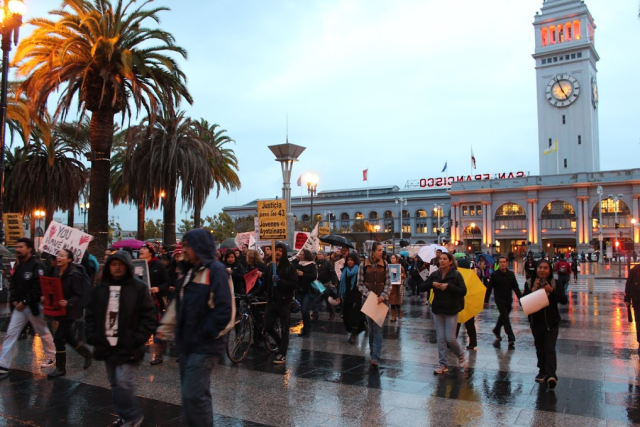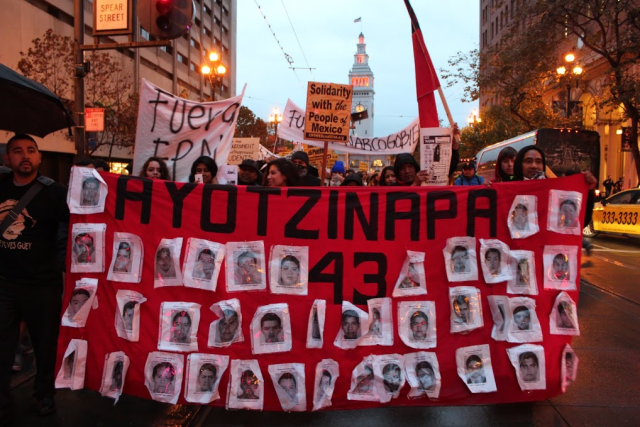
By Caitlin Donohue
NOVEMBER 21, 2014 — If the people of Mexico needed proof that the rest of the world stood with them yesterday, they could look to Market Street in San Francisco. It was the international day of protest for the 43 Ayotzinapa Normal student activists who were disappeared in the Mexican state of Guerrero by rural law enforcement back in September – and also November 20, the anniversary of the start of the 1910 Mexican Revolution.
The San Francisco sky opened up over the hundreds of people marching through downtown, a Mexico-worthy deluge of water, the likes of which the Bay Area rarely sees. The water hit marching protesters chanting, “Quien fue? La policia! Quien fue? El estado! (“Who was it? The police! Who was it? The state!”) But they barely seemed to flinch, reaching City Hall with enough numbers to take the grand building’s steps with protest signs and a puppet of President Enrique Nieto Peña, a likeness whose size paled only in comparison to the one that had been burned hours before in Mexico City’s central plaza.
After all, as one woman proclaimed at the open mic in Justin Herman Plaza that kicked the SF demonstration: “Can you imagine what would have happened in 1910 if a little rain had stopped them?”

In Mexico City the weather was more forgiving, allowing an estimated tens of thousands of citizens to meet at three points around the capital, forming marches that converged at the Zócalo, the historic center of the city. Once there, Ayotzinapa Normal students and family members of the disappeared 43 spoke. A gigantic effigy of Nieto was burned. The protests stayed peaceful until a small group of encapuchados, or masked demonstrators, began throwing Molotov cocktails at police officers. Elsewhere in the city, another conflict with the police was kicked off when protesters looked to block traffic to Benito Juarez International Airport. In the state of Sonora, protesters occupied Congress .
But as other voices explained at the SF rally – and the well-attended demonstration and march that happened earlier that day in Berkeley — the corruption and violence that has Mexican citizens rising up over Ayotzinapa are hardly problems restricted south of the border. Leaving aside the fact that many at yesterday’s march live in the Bay Area but are originally from Mexico, most speakers made the connection between Mexico’s drug violence and the United States’ arms financing and neocolonial interventionism in the Mexican economy. The United States cannot stand aside and watch Ayotzinapa happen, because it is our issue too.
“We believe an adequate immigration policy would be to tear down that goddamn wall,” cried out a speaker into a microphone in downtown’s Justin Herman Plaza. “Whether we’re gay, straight, feminist, student, worker – let’s remember that this is all the same battle,” asserted another. Later, when the demonstration turned into a march that led down Market Street to City Hall, the protesters paused to call attention to Senator Dianne Feinstein’s office. Protest organizers used bullhorns to shame Feinstein for her complicity in our government’s arms trafficking to Mexico.
Around 35 million people claiming Mexican descent live in our country (parts of which used to be within the Mexican borders, let’s not forget.) Our history of interventionism in the country is infamous. International trade policies like NAFTA destroyed many Mexicans’ ability to make a living without dependence on our international corporations. Our government has even admitted to selling guns to Mexican gangsters – like the ones who supposedly murdered the Ayotzinapa 43 — that were later used to slay citizens.
Mexican civic unrest, and malfunctions in democracy, should be traced in part to our country’s influence. The White House, tellingly, has remained totally mute on the matter of the disappeared student activists. Condemning the violence and collusion between government and drug traffickers may be too hypocritical for even Obama’s White House. US media is working hard to paint the current wave of protests in the most violent light possible – all the more reason to strengthen that border wall if the Mexicans are getting wild, right? (For a more accurate look at the majority of proceedings during the Mexico City demonstrations yesterday, look no further than Vice News’ raw footage of reporter Daniel Hernandez navigating the demonstration for 2.5 hours.)
We can only hope the people of the United States are too smart to fall for attempts to distance the struggle of the Mexican people from our own. We’re the ones consuming the drugs involved in our southerly neighbors’ bloodshed, and we’re the ones who elect US politicians that have a disproportionately large say in Mexico’s fate. Actions for Ayotzinapa have been tentatively planned for early December – keep in touch with local activist group Yo Soy 132 Bay Area to stay informed.





